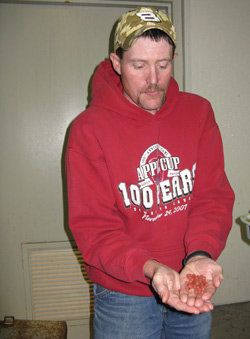 Scott Moore supervises three hatcheries, including Minter Creek. Eggs are kept in trays in the hatchery until they are ready to feed. Photo by Karen Lovett, KP News
Scott Moore supervises three hatcheries, including Minter Creek. Eggs are kept in trays in the hatchery until they are ready to feed. Photo by Karen Lovett, KP News
The busy season for Minter Creek Fish Hatchery gears up again this month when the fish ladders will be churning with returning Chum.
Scott Moore, fish hatchery specialist, is the supervisor of three hatcheries, Minter Creek, Coulter Creek and Huppe Springs. He said he has a lifetime of experience working with salmon. He grew up at the Well’s Hatchery in Eastern Washington where he learned the ins and outs of salmon production from his father, now retired, who ran the hatchery there.
He lives on site at the Coulter Creek hatchery. Two other employees live at Minter Creek. Five full-time and two seasonal employees operate the Minter Creek and Huppe facilities. Someone must be on site 24 hours a day in case the alarm sounds indicating a water pump failure. Young fish and eggs require constant aeration and water exchange for their survival.
The White River Spring Chinook recovery program is a joint effort between Minter Creek and the Muckleshoot Hatcheries. Biologists in Olympia track the numbers of fish. This year Spring and Fall Chinook and Coho numbers are slightly down from the past few years. Puyallup, Nisqually, and Squaxin Island tribes also participate in the hatchery programs.
Future Brood Documents are reviewed by Minter Creek, tribal partners, Olympia and NOAA. If hatcheries in other locations are running short of eggs, all partner tribes, Olympia, NOAA and the hatchery involved must review and approve the transfer of eggs.
Usually fall runs number 7,000 to 10,000 Chinook, 10,000 to 15,000 Coho and 10,000 to 20,000 Chum. Spring Chinook normally have much smaller returns between 600 and 1,500, he said.
Six hundred females produce 1,150,000 eggs.
Fish are forced from the fish ladder into pipes leading to a number of large concrete tanks. All fish are hand sorted. Ripe females are killed and stripped of eggs. Samples of ovarian fluid, kidney or spleen tissue are taken from all females and tested for IHN (Infectious Hematopoietic Necrosis). Males are not tested. Milt is taken from males.
“Chum have the worst flesh, but the best caviar,” Moore said. “Eggs are exported by the tribes to Russia and Japan.” Fish with good meat are sent to local food banks and Northwest Harvest in Grays Harbor. Males have the meat that lasts longest, and it is also made into fish patties. A lot of the meet ends up in pet food, he said.
Eggs are soaked in water and then fertilized and then are soaked in a 100 parts per million iodine solution. Eggs destined to be returned to the wild are kept in creek water, but those that will be shipped out of the area are hatched in well water to avoid transfer of diseases. Well water is 49 degrees. Creek water varies from 38 degrees in winter to 58 degrees in summer.
Moore said, “Eggs are kept in trays in eight rooms at Minter Creek. Each tray can hold 6,500 Chinook or 7,200 to 7,500 Coho or Chum eggs. Between 30 and 33 days the eggs are shocked. They are bounced. This breaks up any unfertilized eggs and they turn white. Then they are run through an egg-picking machine. It uses light. If light can’t go through the eggs it spits them out. It catches most of them. The rest have to be picked out by hand with chopsticks.”
After hatching and consuming the yolk sac at 120 days, they are ready to feed. They are moved outside to ponds as soon as they are ready to eat. They start out eating No. 0 size Bio Oregon Salmon Feed and are fed four to eight times a day seven days a week. They are fed less frequently as they grow. Yearlings are fed once a day, three or four times a week. Sometimes in winter if the water freezes ice has to be broken up so the fish can be fed.
“All spring Chinook are tagged and unclipped; 260,000 sub-yearlings and 75,000 yearlings were released. Not all make it back,” Moore said. More Spring Chinook are shipped as fingerlings to White River acclimation ponds.
“Some Coho wild fish go upstream on Minter Creek,” he said. “We keep some wild fish and integrate them into the Coho. All Coho here have one wild parent and one hatchery fish parent. Wild cutthroat trout are passed upstream. If trout get into traps or ponds, they are caught and taken in a bucket of water and moved upstream.”
Minter Creek Hatchery is located at 12710 125th Ct. KPN, 98329. It was originally built in 1936. It was rebuilt in 1994 and is open to the public Monday through Friday from 8 a.m. to 4:30 p.m. It is also open weekend, but with fewer attendants. To schedule a tour of Minter Creek Hatchery, call 857-5077.
UNDERWRITTEN BY THE FUND FOR NONPROFIT NEWS (NEWSMATCH) AT THE MIAMI FOUNDATION, THE ANGEL GUILD, ADVERTISERS, DONORS AND PEOPLE WHO SUPPORT INDEPENDENT, NONPROFIT LOCAL NEWS